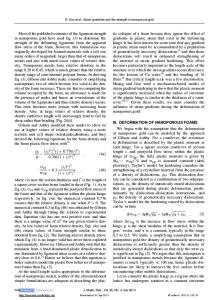The Strength of Gold Nanowires and Nanoporous Gold
- PDF / 1,728,800 Bytes
- 6 Pages / 595 x 842 pts (A4) Page_size
- 60 Downloads / 335 Views
1144-LL21-04
The Strength of Gold Nanowires and Nanoporous Gold Rui Dou and Brian Derby Materials Science Centre, The University of Manchester, Grosvenor Street, Manchester, M1 7HS, UK ABSTRACT We have measured the yield strength of gold nanowires with diameters in the range from 30 to 70 nm fabricated by electro-deposition into porous alumina templates. All nanowire sizes showed yield strengths much greater than polycrystalline gold with the 30 nm specimens having a yield strength of 1.4 GPa. We found no significant work hardening at plastic strains up to 30%. The strength of the nanowires as a function of wire diameter follows the same trend as has been found for the compression strength of larger gold pillars reported in the literature. TEM observations of deformed wires are consistent with mechanisms of dislocation induced deformation. The strength of nanoporous gold nanowires measured by uniaxial compression test is also reported here. Although two different mechanisms are thought to operate in gold nanowires and nanoporous gold respectively, their strengths show very similar dependence on wire or ligament diameter. However the nanoporous material shows significant strain hardening. INTRODUCTION The yield strength of sub-micron gold pillars measured by uniaxial compression test has been reported in many studies [1-3]. There is a significant size effect with smaller diameter pillars showing larger values of yield stress. Possible explanations for this size effect in the deformation of small crystalline structures have been reviewed by Nix et al and can be ascribed to two mechanisms [4], either (1) the presence of strain gradients, in which a geometrically stored population of dislocations leads to strengthening or (2) dislocation starvation, where the presence of a free surface and the associated image forces remove mobile dislocations from the structure, hence, new dislocations must be generated to maintain deformation. Because there is believed to be no strain gradients generated during the uniaxial compression test, the observed size effect in the deformation of sub-micron gold pillars has been generally ascribed to the dislocation starvation mechanism. A similar strength dependence on ligament size is also found in nanoporous gold, although in this case there are significant strain gradients during deformation. In most reports to date, sub-micron, single crystal gold pillars are fabricated by focused ion beam (FIB) machining of bulk gold specimens with the smallest pillar diameter of 180 nm [3]. Nanoporous gold with ligament diameters in the range from 5nm to several hundred nanometers can be fabricated by selective dissolution of the Ag component from Au-Ag alloys. Because of the presence of strain gradients in the deformation of ligaments in nanoporous gold, there is a need to investigate the deformation of nanowires with diameters smaller than FIB machined gold pillars. Here we use porous alumina templates to fabricate gold nanowires, with diameters in the range 30 – 70 nm, by electro-deposition. The mec
Data Loading...











